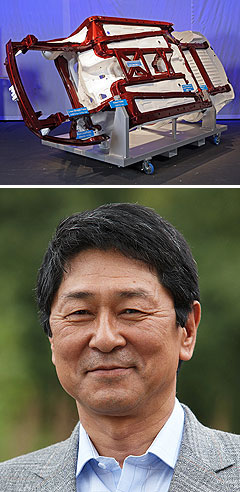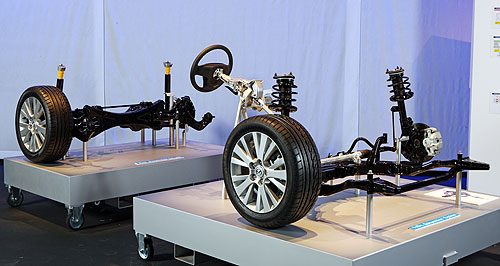Make / Model Search
Future models - Mazda - Mazda6Inside Mazda’s lightweight chassisStrutting its stuff: Mazda’s new architecture, which features a strut front suspension, trailing link rear suspension and revised steering system. We take a closer look at Mazda’s revolutionary new flexible chassis architecture30 Aug 2010 By MARTON PETTENDY in GERMANY JUST as revolutionary as Mazda’s new Sky engine and transmission technology is its sixth-generation C and D-segment vehicle platform, which will underpin everything from the next-generation Mazda3 and 6 to the all-new CX-5 and redesigned CX-7 SUVs. Mazda says its newest chassis architecture is not only stronger than every model in the mid-size vehicle category, including BMW’s 3 Series, but also lighter. A reworked trailing-arm rear suspension with revised geometry is claimed to reduce rear lift and reduce yaw gain at speed and therefore promote high-speed stability. Using struts instead of a wishbone front suspension is lighter, less costly and, along with a range of kinematic and compliance characteristics improvements such as a higher damper lever ratio and greater front caster and trail angles, is claimed to improve low-speed damping performance. In turn, a revised electric power steering system features an upgraded motor with an integrated ECU that is relocated from the steering rack to the column to bring cost, weight, performance and packaging advantages without increasing cabin noise. A tighter 14.5:1 steering ratio (down from 15.4:1) aims to increase low-speed yaw gain and retuned speed-sensitive power assistance is designed to improve off-centre feel. Mazda’s European engineers said the changes were designed to allow drivers to feel subtle changes in direction more quickly than before, resulting in better feedback for more confidence-inspiring low to mid-speed handling and high-speed stability. A 30 per cent increase in torsional bodyshell stiffness is achieved by adopting continuous diagonal underbody members, relocating cross-body beams and increasing the number of spot welds and bonds throughout the body-in-white, which is now 20kg lighter (eight per cent) at 270kg. Mazda said it saved 10kg through structure optimisation, 5kg via material substitution – such as increasing the use of high-strength steel from 40 to 60 per cent – and 5kg by using different manufacturing processes, including a hot-stamped B-pillar.  Body in white: The new platform is eight per cent lighter and 30 per cent stiffer according to Mazda R&D chief Seita Kanai (below) Body in white: The new platform is eight per cent lighter and 30 per cent stiffer according to Mazda R&D chief Seita Kanai (below)Combined with engine, transmission, suspension and braking system weight reductions, the next Mazda6 – which is again expected to achieve a maximum five-star European, Japanese and US safety rating – should be about 100kg lighter than the 1440kg petrol model it replaces. Mazda’s focus on weight reduction will not be limited to vehicles that share the new Mazda6 architecture. The company has committed to reducing 100kg from all its new vehicles from 2011, including the replacements for the BT-50 utility and Mazda2 light-car that are expected to emerge by the end of next year. “Our major product line-up covers from B-car (Mazda2) to mid-SUV (CX-9),” said Seita Kanai, Mazda Motor Corporation’s director and senior managing executive officer for R&D and program management. “Therefore our main global power source is the inline four-cylinder engine. In these segments, we aim to get a strong leadership presence, even though we are not a big player. “We think that the most essential challenge for reduction of total CO2 emissions should be the drastic evolution of base technology. “Through the relentless pursuit of ideal combustion, we are realising a naturally aspirated engine that has better efficiency than we believe any other internal combustion engine, such as downsized turbocharged engines. “Also, we are thoroughly reducing vehicle weight and various driving frictions because these efforts universally contribute to CO2 reduction, regardless of power source. “We have a plan to introduce electric devices gradually, starting from simple technologies. The more complex a drive is, the more expensive it becomes, but as time goes on its cost will come down. “Mazda is working on innovative breakthroughs in base technologies as our most urgent and important challenge. Our technology is not to directly jump to EVs, not to be swayed by external factors such as infrastructure and not to require expensive additional devices. “It should be affordable to all of our customers. Additionally, for vehicles, we will incorporate more than 100kg of weight reduction compared with the previous design, starting with models in 2011.”  All future models Alfa Romeo Alfa Romeo Abarth Abarth Alpine Alpine Alpina Alpina Audi Audi Aston Martin Aston Martin BMW BMW Bentley Bentley Chery Chery Brabham Brabham Chrysler Chrysler Chevrolet Chevrolet Cupra Cupra Citroen Citroen DS DS Dodge Dodge Fiat Fiat Ferrari Ferrari Foton Foton Ford Ford Great Wall Great Wall FPV FPV Haval Haval GWM GWM Honda Honda Holden Holden Hummer Hummer HSV HSV Infiniti Infiniti Hyundai Hyundai Jaguar Jaguar Isuzu Isuzu Kia Kia Jeep Jeep Land Rover Land Rover Lamborghini Lamborghini Lexus Lexus LDV LDV Mahindra Mahindra Lotus Lotus Mazda Mazda Maserati Maserati Mercedes-AMG Mercedes-AMG McLaren McLaren MG MG Mercedes-Benz Mercedes-Benz Mitsubishi Mitsubishi Mini Mini Opel Opel Nissan Nissan Peugeot Peugeot Pagani Pagani Proton Proton Porsche Porsche Renault Renault Ram Ram Rover Rover Rolls-Royce Rolls-Royce Skoda Skoda Saab Saab SsangYong SsangYong Smart Smart Suzuki Suzuki Subaru Subaru Toyota Toyota Tesla Tesla Volvo VolvoMazda6 pricing
Motor industry news |
Click to shareMazda modelsResearch Mazda All future models Alfa Romeo Alfa Romeo Abarth Abarth Alpine Alpine Alpina Alpina Audi Audi Aston Martin Aston Martin BMW BMW Bentley Bentley Chery Chery Brabham Brabham Chrysler Chrysler Chevrolet Chevrolet Cupra Cupra Citroen Citroen DS DS Dodge Dodge Fiat Fiat Ferrari Ferrari Foton Foton Ford Ford Great Wall Great Wall FPV FPV Haval Haval GWM GWM Honda Honda Holden Holden Hummer Hummer HSV HSV Infiniti Infiniti Hyundai Hyundai Jaguar Jaguar Isuzu Isuzu Kia Kia Jeep Jeep Land Rover Land Rover Lamborghini Lamborghini Lexus Lexus LDV LDV Mahindra Mahindra Lotus Lotus Mazda Mazda Maserati Maserati Mercedes-AMG Mercedes-AMG McLaren McLaren MG MG Mercedes-Benz Mercedes-Benz Mitsubishi Mitsubishi Mini Mini Opel Opel Nissan Nissan Peugeot Peugeot Pagani Pagani Proton Proton Porsche Porsche Renault Renault Ram Ram Rover Rover Rolls-Royce Rolls-Royce Skoda Skoda Saab Saab SsangYong SsangYong Smart Smart Suzuki Suzuki Subaru Subaru Toyota Toyota Tesla Tesla Volvo VolvoMazda6 pricing
Motor industry news |









Facebook Twitter Instagram